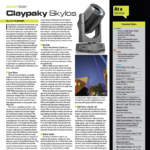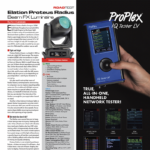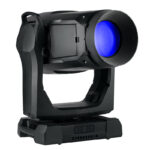I’m staring at a shiny silver/chrome looking piece of love here as I open the case containing a scaled down version of the elektraBar strip light. I easily lift this miniature 11-pound fixture out with one hand and gaze at this architectural model. They make a black one for theatrical use, but this one just looks so stealth. The fixture itself is just under two feet long and about seven inches wide. It has a built-in power supply that is permanently attached to the back.
The Hardware
There are two steel trunnions in the box, which will act as feet for a floor light or can be used to wall mount the fixture. I easily attach them with Tee handles and set the fixture on the ground. I can tilt it 120° in both directions, and the fixture locks in place to hold the focus. I notice these units are quite weather resistant as the AC connectors are indeed rated for IP 65 use and protected when daisy-chained together. (The manual states that 20 of these fixtures can be daisy-chained together from a single 20A AC source.)
In the case I have received, I see several lens options I can choose from. These are optional accessories one can purchase. They offer a 10°, 25°, 40° and 120° beam spread. I’m starting off with the 25° for this test so I can see the power and clarity of the beam itself, with just enough spread to wash an area. They also have an optional shield for the front designed to eliminate glare. This is a great idea, as we don’t wish to see other light beams bouncing off the front of a strip light facing the audience (or a rear cyc, for that matter).
I plug this fixture into a regular 110V wall outlet with the adapter they gave me. The power supply on this fixture can self sense 100-240 volts and run on whatever voltage we feed it. It starts right up, and I address it seamlessly through the LCD screen/menu options. To test it properly, I’m running her in 60 channel DMX mode to ensure that I can control every individual function of this strip light. There is an 11-channel basic mode, too. I feed it DMX straight from a console into the 5-pin XLR port. There are through ports for daisy-chaining signal as well as power connections.
There are eight individual 6-in-1 LED cells. They consist of your typical red, green, blue and white cells while adding in an extra amber and Indigo emitters.
The LEDs themselves are 12 watt, but they have a pretty big open face to spread the light out. Although 20-watt bulbs would be brighter, when I think of the compactness of this fixture, the wattage will suffice nightly. Channel 1 is the master intensity for the whole fixture while channels 2-7 are the individual colors for the whole mini strip. Sure enough, I put all six colors at full, and it is plenty bright — too painful to stare into, for sure. I point it at a wall from about 10 feet away. The size of the image on the wall is a linear rectangle that is about 30 inches tall by 60” wide. My meter is reading about 1,500 lumens at this distance, which is fair. I move the fixture up against the wall to check its ability to wash a wall or cyclorama. The individual light beams from each cell blend well, and there is not much striping at all. The fixture shoots well about 15 feet up the wall before the light dissipates. To get an even cyc wash one would need to use a top and bottom ground row, as expected.
Colors and Dimming
The colors are deeply saturated. Mixing lavender and blue-green colors is often a chore with LEDs. The Indigo light makes a noticeable difference when I add it to magenta and blue mixes. The light doesn’t get truly saturated, but it certainly aids the lavender field. I only have one fixture, so I am unsure how UV treated objects will appear under just the Indigo emitter. The amber allows me to mix some fine CTO and sienna type colors as well. It also gives me some rare strange hues when I mix it with primary colors. Where this fixture excels in my book is the pastels it mixes. I can get a gorgeous Follies Pink as well as the teal I strive for out of these fixtures. A diffraction lens covers each cell, which keeps the 6-in-1 LEDs looking very uniform in color.
Time to test the color range against each other. I put the fixtures in a solid blue wash. Using the individual color channels for the green cells, I fan the values on my console so green is at zero at one end of the light and at full at the other. Indeed, I have eight different blue hues ranging from dark blue to cyan. I run all kinds of chases that the fixture performs —perfectly, as expected.
The dimmer curve is pretty sweet and linear in its default state. I notice no dips other than the expected pop to black one gets when they are at about 3 percent intensity. There is a channel just to set your dimmer curve. I check it out and notice they offer four different speed times for the intensity. This is clever as well as useful if you planned on using the fixtures in stand-alone mode without a controller. I run some slow sine wave chases and peels back and forth and it executes the moves flawlessly. I write some custom dimmer chases with zero time on the uprate and 3 seconds on the decay, and they perform okay. I can’t really emulate the reaction one would see with a tungsten bulb, but not many LEDs have that electronic capability. There is a separate strobe channel that works on the entire fixture. It provides sync modes and random strobe variations that provide great effects.
Speaking of Effects
With individual control of all eight cells, one can write eye candy chases all day long. For fun, I grab the cells and put them in a few different chases at once making them react like a Tokyo storefront window. But I want to check out the macro channel to see the pre canned effects. They have eight built-in auto programs to choose from on this channel, and they all do different things with various speeds. I also find a separate channel that controls the speed of some effects.
If I turn the macro channel to full, it puts the fixture into sound activation mode. I was able to get flashes of light by clapping my hands. I did not test it in front of a loud audio source, but I imagine it could augment a DJ or roller rink just wonderfully.

At a Glance
Compact Mini Strip Light
ElectraLite’s electraBar Mini is a tight, compact little fixture that has a ton of value for many applications. It’s small enough for a storefront window, and users can also hide in a corner of a stage. This should prove to be a great fixture for the House of Worship and install market as well.
electraBar Mini
PROS:
- Lightweight and easy to mount. Superb color mixing ability. Individual cell control. IP65-rated.
CONS:
- No zoom function, but beam angles can be altered with lensing.
Stats:
- Size: 23.6” x 7.8” x 3.5” (L x H x W)
- Weight: 11 lbs.
- Power: 140 watts
- MSRP: $699
- Manufacturer: elektraLite
- Distributor: Group One Ltd.
- More Info: www.myelektralite.com , www.g1limited.com



